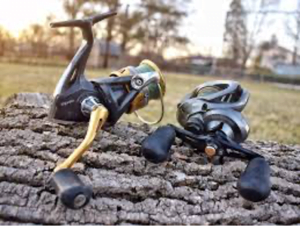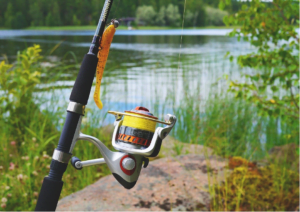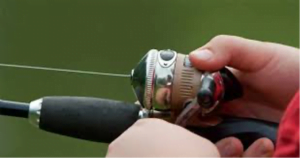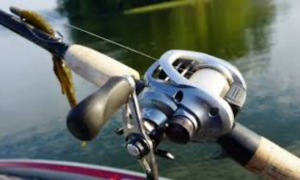 Bass is one of the fishes that entice and excites beginners. They are fast and gives you the thrill of fishing.
Bass is one of the fishes that entice and excites beginners. They are fast and gives you the thrill of fishing.
The weapon of ultimate fishing is the reel. If you select a bad reel, it will not only sabotage your fishing experience but also prove highly demotivating. Bass fishing reels are selected on various factors, including your fishing technique, personal preference, and experience.
Whether you are fishing from dock, shore, or kayak, there is always a specific category of a reel that proves to be exceptionally helpful to beginners.
Today, we will discuss all the components of the bass fishing reel for beginners, followed by a comprehensive discussion on different types of reels.
Looking for the fishing rods for beginners?
Anatomy of Fishing Reel
Line Pickup: It helps in winding or wrapping the line on the spool.
Spool: It has a sprocket-like structure to wrap the line.
Engager/Disengager: This mechanism allows the line to come off the spool or locks it in place
Drag Component: It helps in slowing down the line while coming off the reel
Handle: It is used to turn the internal gears and retrieve the line on the spool
Reel Seat: It is the place on the rod where the reel sits
Break System: It is an advanced system on the rods that help in slowing the lure’s spin after it has hit the water
What Type of Reel is Best for Bass?
 3.1. Spinning Reel
3.1. Spinning Reel
If you are a beginner, spinning reel is a great option. It is affordable, lightweight and easy to use. With this reel, you can undertake differently sized bass.
The spool on the spinning reel sits parallel to the rod’s main axis. It is usually beneath the rod, unlike its counterparts, that has the spool on the top of the rod.
The line is wrapped around the spool and passes from a small wheel called the power roller. The metal arm, known as the bail, keeps the line in place and make sure that it conveniently passes over the power roller.
The spool rotates when the handle is turned while reeling in line. A single revolution of the handle makes the spool rotate more than once. Due to this mechanism, spinning reels are also known as multiplier reels.
To start casting, you should first move the bail arm to the up position. This is called opening the bail. It helps in freeing the line and allowing it to unspool so that you can keep the line tight by pulling it. This process is done while preparing to cast.
You need to maintain the pressure on the line as you backswing and release it at the end of the casting motion. This one is not too complex to understand, and you don’t need a lot of practice to become a pro.
The reel is an affordable alternative. It is lightweight and easy to manage. Also, it can take the beating caused by bass fish.
However, the common problems that most anglers come across are twisting of the line. When the line tangles, you will have to unspool all of it to flatten and then rewind it on the spool slowly and carefully.
If you understand the technique completely, there are rare chances of your line twisting. We suggest that before taking the spinning reel to catch the bass, you try using it on other small fishes to understand the mechanism.
Pros
- Easy to use
- Affordable
- Lightweight
Cons
- Backlashes and line tangles
 3.2. Spincast Reel
3.2. Spincast Reel
The spincast reel was invented in the 1940s by the Zero Hour Bomb Company. Over time, there has been a drastic transformation in these reels. It is actually derived from the spinning reel with a bit of difference. Spincast is best suited for handling light fishing jobs that does not require hard drag.
Basically, it is fitted with a plastic cover. The line emerges from the hole at the reel’s front. The working and design are very similar to a spinning reel. However, you will find some prominent distinctions as well.
There is a spool that runs parallel to the rod axis. It is un-rotating during the cast. Instead, the line will unspool as the lure’s weight pulls it free.
In contrast to the spinning reel, this one is easy to use as it does not require the angler to hold the line in place while making a cast. You just have to press the button to cast, and the line will unspool freely.
Another benefit of the spincast reel is that due to the plastic housing covering the line, there are no tangles on the reel, and you can easily pull it back. This will potentially decrease the chances of technical errors in your game. Of course, due to this reason, most beginners prefer spincast reel over any other for their first bass game.
The high-quality spincast reels hardly malfunctions, but there could be a problem of line-twisting. Considering the fact that bass is a bit aggressive fish and gives you a hard time during the game, the additional control rendered by spincast reel is highly appreciable.
You will find it easy to use and quickly add more line capacity with an additional reel. Moreover, due to the lightweight, it is easy to switch left and right-hand orientation. The drawback is that they don’t have high drag ability.
Pros
- Usage convenience
- Does not tangles the line
- Less line twisting
- Easy switching from left to right hand orientation
- Lightweight
Cons
- Does not have high drag ability
 3.3. Baitcasting Reel
3.3. Baitcasting Reel
The baitcasting reels are very different from the spinning or spincast reels. Technically, this reel is meant for the professionals that have enough practice of using its best techniques.
As far as the design is concerned, it does not have the spool placed parallel to the rod’s axis, but the spool is mounted so that it can sit perpendicularly to the rod. The spool is located on top of the rod.
Unlike its counterparts, the baitcasting reel’s spool spin during the cast. This means that your lure has to be heavy in order to pull the line free.
Honestly, the baitcasting reels bring results, but they need a bit of practice to successfully catch a fish like bass.
You have to adjust the reel properly and use your skills to ensure that it does not spin further when the lure has hit the water. If the angler is not careful and the reel continues to turn, then it will result in major backlash. The line will get tangled, and it will increase a lot of work for you.
But on the plus side, with the free-spinning feature, the baitcasting reels give you better control over the rod and enhance the casting accuracy. This feature will be useful during long-distance casting.
Whenever you want, you can stop the reel from spinning using your thumb. This way, the lure will fall straight into the water. It is normally helpful when you have to target small bass.
Another thing to notice is that the spool of a baitcasting reel is smaller than a spinning reel or a spincast reel. This means that you can quickly collect more line with better accuracy. This feature helps while using lures that are designed to be retrieved quickly.
Overall, the baitcasting lures are lightweight, durable, and can hold heavier lines. Also, these have strong drag capability and can cast to more distance than others.
However, the usage complexity makes it unfit for beginners. This lure needs more experience and practice to achieve perfection.
Pros
- Hold heavier lines
- Longer casting
- Quickly retrieves
- Easy to stop the reel from spinning
Cons
- Needs experience to use perfectly
Other Important Features
4.1. Line Capacity
The line capacity is the maximum line’s length that a spool can accommodate. As the line’s diameter increases, its strength increases alongside. This means that higher test lines take more spool space. It is important to match the line capacity with respect to the targeted fish for an efficient game. Ideally, for bass, you need 14 – 18 pounds line capacity.
4.2. Drag
The drag is to moderate the amount of force you can put on the line before it snaps, or the spool will slip. It is usually set between 20 – 30% of the line’s breaking strength. You should pick the reel with rear drag as it gives better control.
4.3. Gear Ratio
The gear ratio is the number of times a rotor revolves on a single rotation of the handle. For example, a 6.2:1 gear ratio indicates that the line will wrap 6.2 times on a single handle rotation.
4.4. Bearings
It is better to have as many ball bearings a reel can have. But at the same time, you should be vigilant about their quality. Use anti-rust ball bearings if you are planning to fish in ocean or saltwater conditions.
Conclusion
Finding the best fishing reel for bass can be challenging because the fish is very active and gives you a fight during the catch. You need a reel that has favorable line capacity, a quick drag system, and a high gear ratio.
Bass will need some time and patience from the angler. Even with the best tools and gears, you may have to face disappointment. You need to have some practice of using a certain kind of reel to give it a go on bass.
If you persist and preserve, you will be able to catch bass in a few attempts.




